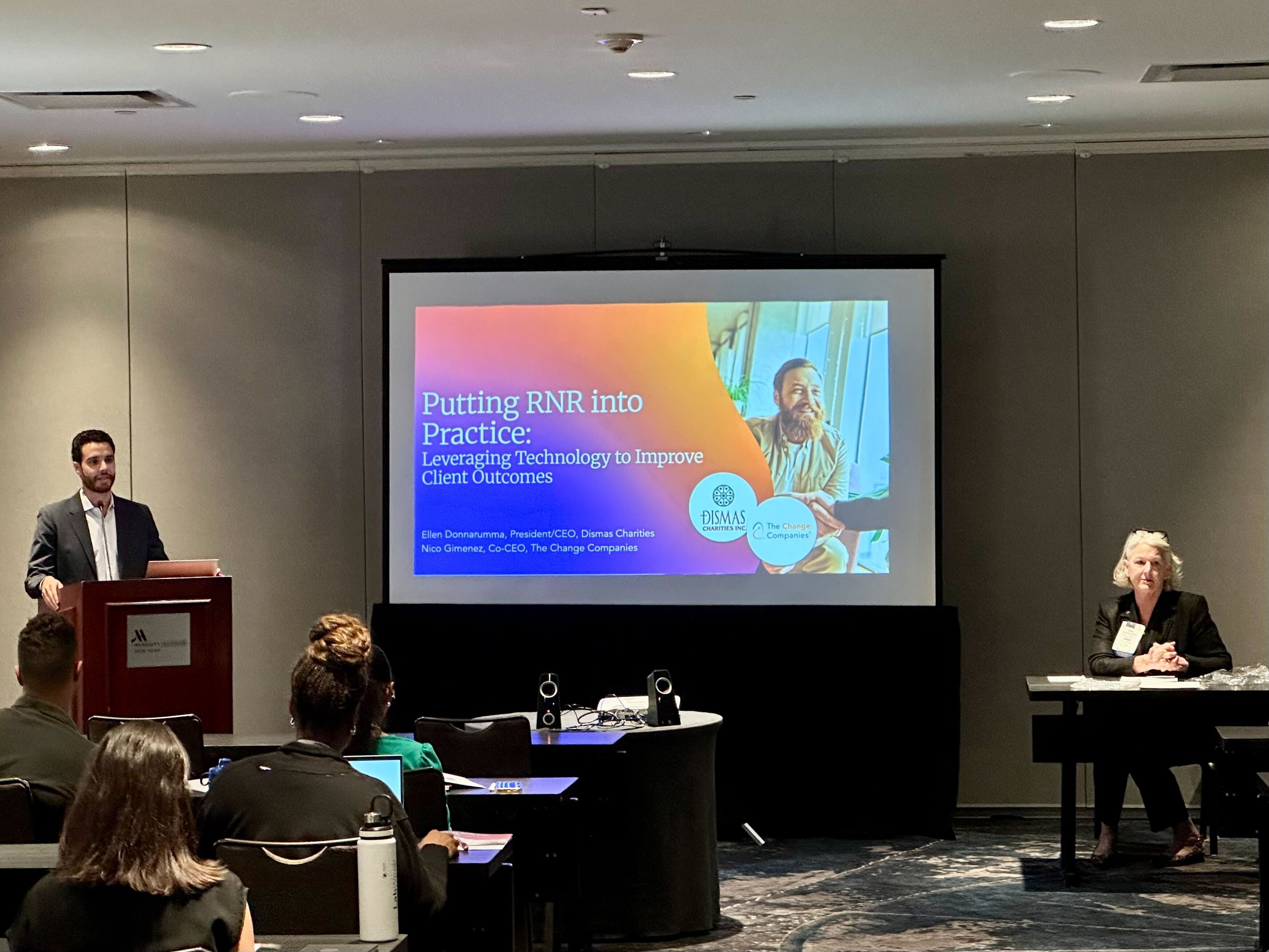The Change Companies and Dismas Charities share major announcement at APPA conference

At the American Probation and Parole Association (APPA) conference this summer, two leaders shared a story of how digital tools are helping to bring evidence-based practices to life in reentry settings, in addition to announcing a major expansion of the Atlas digital platform.
The session featured Ellen Donnarumma, CEO of Dismas Charities, and Nico Gimenez, Co-CEO of The Change Companies, in a conversation about how technology can support the Risk-Need-Responsivity (RNR) model. Their announcement that Dismas will expand the Atlas digital platform from a five-site pilot to 40 centers nationwide underscored both the promise and the practicality of digital transformation in community corrections.
The Risk-Need-Responsivity (RNR) model is widely regarded as the gold standard in corrections. It holds that services should be:
- Risk-focused, matching intensity to an individual’s likelihood of reoffending.
- Need-driven, addressing criminogenic needs that contribute to the individual’s criminal behavior.
- Responsive, delivered in a way that matches an individual’s abilities, learning style, and motivation.
In practice, applying RNR in busy reentry centers is far from simple. Ellen, who has worked in criminal justice for more than 30 years, explained, “I am a firm believer in RNR. I am a deeply committed professional to evidence-based practice. But I’ve been known to say that the reality of daily life will eat evidence-based practice for breakfast, lunch, and dinner.”
Counselors juggle assessments, case planning, employment checks, medical certifications, home visits, and group facilitation—all while serving residents whose lives are often in flux. “There is no such thing as a typical day for one of our counselors,” Ellen noted. Delivering consistent, high-quality interventions under these conditions is a major challenge.
Bridging the gap between theory and practice
Nico introduced Atlas as a way to make RNR both manageable and measurable at scale using platforms like Atlas. “Atlas is the most engaging way to deliver and measure cognitive behavioral programming at scale,” he told the audience.
Atlas combines cognitive-behavioral curricula with motivational interviewing, allowing residents to complete Interactive Journals independently on smartphones, tablets, or desktops. Staff can view dashboards that track engagement, flag concerning entries, and generate summaries with suggested talking points for sessions.
For agencies, this means less guesswork. For residents, it means mobile-friendly programming that feels more individualized and accessible. As Ellen put it, “How do we take that nose-in-the-phone time and make it more productive?”
Pilot results: Five sites, big lessons
Dismas launched a pilot across five volunteer sites, each with staff “champions” leading implementation. Interventions were designed around each individual’s SPIn assessment results to ensure risk-need-responsivity. The approach was collaborative: frontline staff and residents provided candid feedback that directly shaped product improvements.
The results over a 90-day period were striking:
- 470 hours of programming delivered
- 1,200 sessions completed
- 80% of onboarded residents actively engaged
Residents gravitated toward content on mental health, parenting, anger management, recovery maintenance, and medication-assisted treatment (MAT). One counselor reported, “One of my residents actually told me he took his time out when he was having an angry moment and journaled instead of just responding negatively. I could see the difference when I read the Journal.”
Staff also found Atlas helped spark more substantive conversations. As one practitioner shared, residents appreciated knowing their reflections were being read: “He said, ‘Oh, you actually read my stuff.’ It made him feel seen.”

Scaling up: 40 centers nationwide
The positive response from both staff and residents convinced Dismas leadership to expand Atlas across its 40 reentry centers. The rollout will proceed in stages—five centers at a time—to ensure quality and consistency.
Ellen highlighted how diverse centers embraced the platform in different ways. The Atlanta site, a large metropolitan facility, leaned heavily on smartphones. Manchester, Kentucky, a small rural site with an older population, preferred desktop access in the computer lab. Despite these differences, both sites “totally took to it,” she said. “I anticipated that our staff were going to like this and feel it was a useful tool. I am thrilled to see how well-adopted it was by our residents and how eager they were for more.”
Importantly, the technology is not seen as a replacement for human interaction. “This is not about replacing people, it’s about enhancing the experience," said Ellen. “It’s helped our counselors evolve the way they interact with all of the residents all of the time—because there’s a better connection, a better relationship.”

Looking ahead: Technology and the future of RNR
Resident feedback is already shaping future updates. Requests for more engaging content have led to new videos and podcasts and upcoming AI features for residents. Language accessibility is expanding, with Spanish prioritized in upcoming releases. Audio features and text-to-speech are improving accessibility for residents with lower literacy levels.
For Nico, the focus remains on results: “We’re really, really focused on driving outcomes,” he said. “One common concern initially was that technology would be replacing the role of counselors. But what we’re seeing is that it’s fueling human connection, not replacing it.”
The APPA session illustrated how technology, leadership, and culture intersect to make evidence-based practices real in the field. By pairing RNR principles with digital innovation, Dismas Charities is demonstrating how a large, diverse organization can move from theory to practice—one resident, one Journal, and now, one site at a time.

